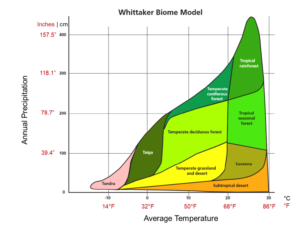Enrichment for Humans: Climate Cues
In our modern world of heating and air conditioning, you might not think a lot about what kind of climate you live in, and how the wildlife in your area has adapted to that climate! In this activity, we’ll find out what kind of habitat you call home based on real weather and climate data.
Before you begin:
What’s the difference between weather and climate? Weather describes daily conditions, while climate describes long-term weather patterns in a specific region. For example, it might be raining today in Arizona, but that doesn’t mean that Arizona has a rainy climate! We can understand what an area’s climate is by looking at historic weather conditions for 30 years or more. Weather and climate data tell us a lot about how an area’s climate might be changing.
What you’ll need:
- Access to https://www.usclimatedata.com/
- The graph below: Whittaker’s Biome Model

Instructions:
- Visit https://www.usclimatedata.com/climate/united-states/us and find your state on the map.
- Click on your city or the one you live closest to.
- On this page, you can find average temperature highs and lows and precipitation for your city. Scroll down to see the climate graph, showing average temperatures and precipitation over the year.
- If you’d like, explore the “History” tab at the top, and compare average temperatures and rainfall from this year, to years in the past. Compare temperature and precipitation from December 2021 to December 2007.
- Based on the average annual temperature and precipitation (annual average can be found in the box to the right of the graph), decide what biome your city is located in. The graph below can help!
- Once you’ve determined your biome, identify one adaptation that the animals living in your region have to deal with seasonal change.

